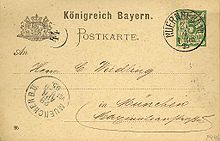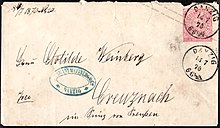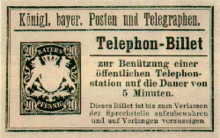Postal stationery


Postal stationery is philatelic receipts that have been paid for in advance and printed with stamps , for example postcards , envelopes , wrappers, card letters, but also telephone tickets and postal orders . In addition, the following types are less common: Folded letters (if sent by airmail = aerograms ), telegram sheets and parcel cards. A postal stationery is a postage stamp like a postage stamp and thus a receipt for the use of normal postal services. For this reason, unused postage stamps that have been cut out could be used as postage on other postal items by many postal administrations.
For the buyer, the advantage lies in the combination of postcard / envelope and appropriate postage in one product. No further postage stamps are required if the postage is correct; after a postage increase or for additional services such as B. Registered mail, the missing amount is supplemented by postage stamps.
Another advantage is often the lower price of the postal stationery compared to the individual purchase of postcards or envelopes and stamps. Many postal administrations (Germany until 2003) deliver the postal stationery at the price of the postage printed on it.
In the philately postal stationery are a popular collectible, especially real spilled postal stationery from daily life. They tell more about themselves than a stamped stamp. Among other things, the place of dispatch, date, sender, addressee, and in earlier decades sometimes also the arrival stamp can be seen. Mint postal stationery is also available as part of yearbooks .
With the introduction of the Plusbrief individual , customers can create their own postal stationery with a print run of 20 or more.
In contrast to postal stationery, entires have no stamp imprint. Philatelic receipts with stamp imprints will continue to be called postal stationary if they have been given additional postage to supplement postage .
definition
According to the article “What are postal stationery” in: The postal stationery No. 1–2 / 1975, pp. 9–16 by Dr. W. Fricke, they are determined according to the following criteria:
- There must be postage.
- The fee is payable in advance.
- As a rule, there is a stamp imprint.
- There are also postal stationery without a stamp in the following cases:
- The fee is shown on the postal receipt, such as B. the international reply coupon .
- The fee is confirmed by an official seal, such as B. in the Bremen city post envelopes.
- The fee is confirmed by a control stamp, such as B. in some emergency expenses or in the so-called corking of the Soviet Zone (SBZ) after the Second World War.
In the same article by Fricke, a collector is quoted as follows:
“The item in question is to be regarded as a postal stationery with a value stamp if it is printed on it that the postage for the transport has already been paid. It does not matter whether this amount is named by itself. "
Collectibles in this extended definition would expand the scope of catalogs considerably, so they are not always listed in it.
The German term postal stationery comes from the Berlin stamp dealer and examiner Julius Schlesinger (1858–1920).
history
precursor
- 1637: First stamp paper in Spain from January 1, 1637 (stamp paper often had stamps)
- 1818 to approx. 1836: Sardinian horses.
- 1838: Forerunner from New South Wales with stamps in relief.
First postal stationery and their distribution
- 1840: Mulready postal stationery appears in England; they are considered the first postal stationery. They were printed over the entire surface with a symbolic picture motif and they were available as folded letters or as envelopes, each with a value of 1 penny or 2 pence. It was sold from May 1st, the first day of validity was May 6th. Due to complaints about the cover design by the artist William Mulready (1786–1863), it was withdrawn shortly afterwards. The first postal stationery was mostly completely designed envelopes that had nothing in common with the usual impression of a normal postage stamp in an envelope.
- 1846: First postal stationery in Switzerland: official from the canton of Geneva.
- 1849: First postal stationery in Germany from Hanover.
- 1851: First Prussian postal stationery.
- 1861: First postal stationery in Austria.
- 1869: First postcards from Austria, which are also the first postal stationery postcards .
- 1870: First German postal stationery postcards from Württemberg.
- 1923: Picture postcards from Switzerland.
- 1998: On June 10, 1998, Deutsche Post AG introduced the “ Plusbrief ” as a new product. But it is postal stationery. From this point on, these will only be named differently by Swiss Post.
Types of postal stationery
Ad postal stationery
These are envelopes, folded letters, card letters and postcards with a large number of small company advertisements and stamp imprints on private order issued by private advertising expeditions. In private trade, these were accepted as part of their value by the advertising companies at the price of the value stamp. Especially with postcards and card letters, only a small writing surface remained. There are postcard booklets with various individual advertisements per card and on interleaves (perforated vertically on the left).
Outside of this specification are subsequently printed official postal stationery in the same way (see section “Additional prints”). Official or private postal stationery with advertising texts from the sender (e.g. offer from a company, order form, invitation, etc.) are also not classified as advertising postal stationery.
Envelopes
In addition to the official ones, there are also private envelopes as well as folded letters (= letterheads that could be folded up using protruding, gummed folding flaps) and postal order envelopes .
Wrapper
Wrapper , even wrapper paper (StrbZtg) called, is the delivery of newspapers as a mailing . The wrappers that hold the newspaper together often have postage stamps on them and in this case are classified as postal stationery. Printed sheets with and without dividing lines had to be cut into strips, each of which had a stamp . These were used to send newspapers and magazines . Today wrappers in the form of labels are mostly used, from which address information and the number of the postal item for postage confirmation can be found. These are attached directly to the magazine or - mostly in the case of international mail or to prevent the loss of a mail due to theft - on an envelope. On July 1, 2011, the Streifbandzeitung became subject to sales tax. For this reason, franking with postage stamps or as an individual plus letter is no longer permitted. As a replacement, a product brand Streifbandzeitung was introduced for domestic mail on July 1, 2011.
Card letter
Card letters , also wrongly called folded letters , were a simplified letter form, consisting of a double card that was broken once, and in some countries twice broken, the edges of which, partly rubberized and perforated all around, were glued together when the card letter was closed and torn off when opened. Card letters were used to transmit shorter messages which could not be written down on a postcard due to lack of space or which should not be read by anyone other than the recipient; they were subject to the regulations and fees for ordinary letters. Card letters were invented by the Hungarian Karl Kohn, called Károly Akin, in 1871. They were first used on May 1, 1879, in France by the Pariser Rohrpost , in Belgium in 1882 and in Austria in 1886 . In the following years they were used in most other European and several American countries. The Deutsche Reichspost created the card letter as a new mail item on November 1, 1897. Until the World War, forms with imprinted stamps (10 pfennigs) were sold at face value by the post offices in the Reichspost area. In June 1922, the Deutsche Reichspost abolished card letters because of insufficient sales.
postcard
- see postcard
- Perforated postcard
- Reply card
- World postcard
- Picture postcard
- Publibel card
Money order
Postal orders as postal stationery were issued in Germany until 1922 (after 1922 only as a form). They usually had a two-part or three-part form. In the Kingdom of Württemberg there were also postal order envelopes and postal order service envelopes in which messages could be placed.
Special postal stationery
For the same reasons as with special stamps , some postal administrations also issue special postal stationery (mostly as special postcards or special envelopes, sometimes also as special folded letters). Such special postal items can, but need not, have a special stamp impression; But there are also special postal stationery on which the permanent stamp, which is also valid, was used.
Postal stationery with private prints
Most postal stationery is designed to accommodate the user's correspondence. Even if this is usually applied by hand, private individuals are not forbidden from printing the rooms provided for correspondence. This results in postal stationery with private imprints which at first glance can be confused with special postal stationery. In some countries and at some times this additional print could already be ordered from the postage stamp printer; but this does not change the fact that these are not special issues.
The assignment is not always easy if the additional printing was initiated by a state-affiliated institution. For example, Italian postcards from the 1920s with propaganda slogans for the fascist party are being discussed as to whether they should be viewed as official issues.
The history of the development of collecting
Kalckhoff wrote shortly before 1900 that there was a great boom in collecting postal stationery in the 1880s and 1890s. At first, postal stationery clippings were collected, which was increasingly frowned upon by the beginning of the twentieth century. Instead, the entire postal stationery was collected. Early albums often had their own sheets that were intended for postal stationery clippings. Today there are still preprint albums for collectors, but now for the complete collectibles. There have probably never been as many postal stationery collectors as collectors of postage stamps. They were often collected by stamp collectors only on the side. Purely postal stationery collectors have always been the exception. Now that significantly fewer postal stationery items are being sent, the area has also become significantly less popular with collectors. The great age of postal stationery seems to have long since passed. Astounding prices are still achieved for some postal stationery, such as B. for the Prussian octagons.
Important collectors
- Carl Lindenberg (1850–1928), lawyer
- Franz Kalckhoff (1860–1955), chemist
- Siegfried Ascher (1877–1962), architect
- Petschek family
literature
General works
- G. Weileder: Philately correspondence course for postal stationery , letters 1 to 7, Philatelic Academy of Bavaria, Forchheim 2010
- E. Stenger, F. Kalckhoff, S. Ascher (eds.): Festschrift to celebrate the 25th anniversary of the Berlin postal stationery collectors 'association , Berlin postal stationery collectors' association, Berlin 1926, 205 pp.
- The Collectors' Guide to Postal Stationery , 1997, ISBN 0-947604-07-3 , 88 pp.
Magazines
- The postal stationery : Joint magazine of the Berlin postal stationery collectors' association from 1901 e. V., of the Munich postal stationery collectors' association 1912 e. V. and the postal stationery working group in the BDPh. e. V.
- The postal stationery collector: Bulletin of the Swiss Postal Stationery Collectors Association
items
- Postal stationery philately, location and status. In: The postal stationery No. 3/1977, pp. 90–93
- Big issues and little answers for postal stationery collectors and those who want to become one. In: Die Ganzsache , No. 1/1980, pp. 20–30
Web links
- Postal stationery - novelties
- Munich Postal Stationery Collectors Association 1912 e. V.
- Berlin postal stationery collectors' association from 1901 e. V.
- Postal stationery from the Museum Foundation Post and Telecommunications
- Swiss Postal Stationery Collectors Association (SGSSV)
Individual evidence
- ↑ Horst Hille: Collecting and shaping . 2nd, unchanged edition. transpress Verlag, Berlin 1973, p. 40
- ^ The postal stationery , 1939, p. 18
- ↑ Mirror, mirror, on the wall - who is the oldest in the whole country? A contribution to the history of the (picture) post (view) card (2) In: philatelie - the collector's magazine of the Association of German Philatelists, issue 309, March 2003, p. 55
- ↑ Mirror, mirror, on the wall - who is the oldest in the whole country? A contribution to the history of the (picture) post (view) card (2) In: philatelie - the collector's magazine of the Association of German Philatelists, issue 309 from March 2003, page 54 f
- ↑ a b Postal stationery: Schwendter Briefmarkensammlerverein , accessed on November 16, 2011
- ↑ Jürgen Olschimke: The Streifbandzeitung - Review and Outlook . In: Philately and Postal History , 332, philately , 411, September 2011, p. 33 ff.
- ↑ The German postcards. In Senf's Contributions to Postage Stamp Studies (Extraordinary Supplement to the Illustrated Briefmarken-Journal ), Volume 3, No. 6




